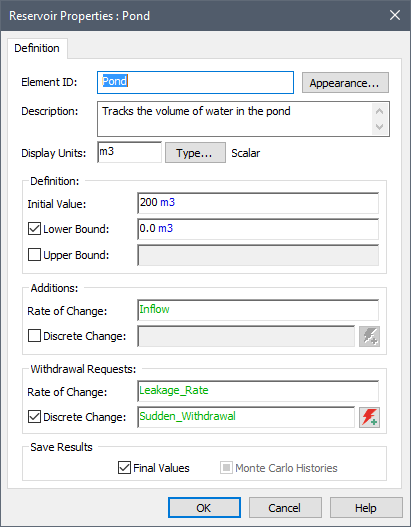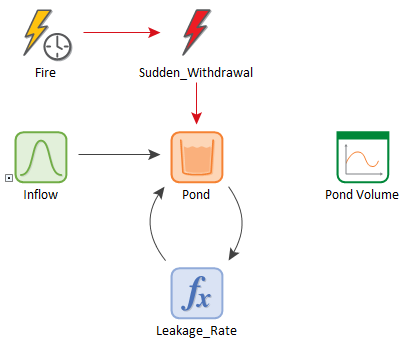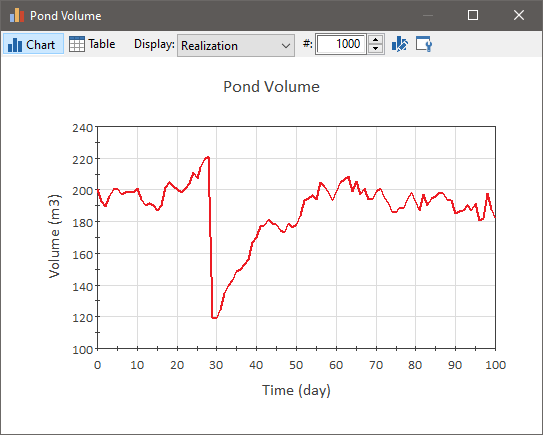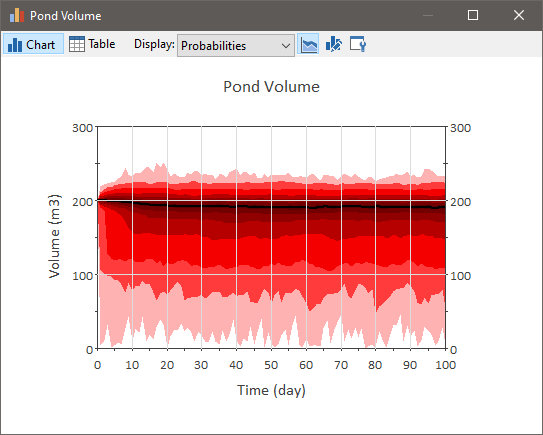Linking the Sudden Withdrawal for Fire Suppression to the Pond
Lesson 4, page 11 of 14
Now that we have defined the Fire event and we have defined the consequence of the event (Sudden_Withdrawal), we now need to link the Sudden_Withdrawal to the Pond.
Link the Sudden Withdrawal of Water to the Pond:
-
Double-click on the Pond to open its Properties dialog.
-
In the section labeled Withdrawal Requests, check the Discrete Change box. This activates the field directly to the right.
-
Enter "Sudden_Withdrawal" into this field.
We can do this by simply typing in the name. As you begin to type, GoldSim provides a list of suggestions for output names that are consistent with what you have entered so far. Left-click on Sudden_Withdrawal in the suggestion list. -
The dialog should look like this:

-
Press OK to close the dialog.
The graphics pane The primary portion of the GoldSim interface, where the graphical depiction of the model is shown. should now look similar to this:

Now let's run the model again.
Run the Model:
- Click Run on the toolbar:

- When the model finishes running, a "Simulation Complete!" message is displayed. Press OK to continue. The model is now in Result Mode The state of a GoldSim model when it has been run and contains simulation results..
- Double-click on "Pond Volume" to view the result. Make sure that at the top of
the display dialog, Display is set to "Realization A single model run within a Monte Carlo simulation. It represents one possible path the system could follow through time.". You can toggle through the
various realizations using the spin control to the immediate right of the
Display field. The various realizations will all be different, but
will look similar to this:

What you will see is that the volume in the Pond randomly varies around 200 m3, but occasionally, there is a sudden withdrawal of 100 m3, after which the pond recovers back toward 200 m3.
Of course, what complicates the problem is that the fires occur about once every 50 days randomly. So on average they will occur twice per realization, but if you toggle through the realizations, you will see that in some realizations they occur perhaps five times (or more), and in some realizations, they don't occur at all.
Of course, it is in those cases where multiple fires occur close together that we would expect the pond to drop to zero.
We can get a hint of the frequency of this by viewing the percentiles of the time history data (by setting the Display to "Probabilities"):
The lightest color here corresponds to a percentile range of 0 to 1% (you can see this in a tool-tip by putting your cursor over that range), so this indicates that it is fairly rare to run out of water. - Close the Result element An element that can be used to organize, analyze and display results. by pressing on the X.
- Press F4 to return to Edit Mode The state of a GoldSim model when it is being edited and does not contain simulation results..
- Press the Save button in
the toolbar (or press Ctrl+S):

Although the probability chart above indicates that running out of water is likely to be rare, we cannot use this chart to actually quantify that probability. In order to do that, we need to add one more element, which we will do next.